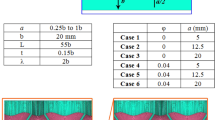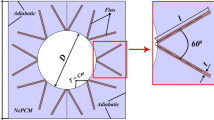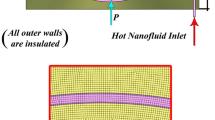Abstract
The aim of current investigation is to model NEPCM behavior in an air heat exchanger storage unit by means of FVM. Unsteady governing equations are obtained including single-phase model for NEPCM. Thermal properties of paraffin are enhanced with dispersing CuO nanoparticles. The geometry was symmetric, and so there is no need to simulate the whole domain. Converting liquid to solid makes the air flow warmer and helps the ventilation of building. Wavy wall was employed to accelerate the discharging rate. Outputs reveal that dispersing nanoparticles leads to propagation of solid front. Discharging rate enhances with augmenting amplitude of inner wall.
Similar content being viewed by others
Explore related subjects
Discover the latest articles, news and stories from top researchers in related subjects.Avoid common mistakes on your manuscript.
Introduction
Possibility of saving large amount of energy and great energy density are main characteristics of PCMs. Solar air heating units are one of the nice applications of them. In recent years, NEPCM was offered to use instead of pure PCM. In this way, is storage energy enhanced. Bondareva et al. [1] utilized alumina to enhance thermal properties of PCM in a cooling unit. They concluded that performance is augmented with adding alumina. Innovative shape of heat storage system has been suggested by Sheikholeslami et al. [2]. They also utilized nano-sized particles to expedite discharging. Raizah et al. [3] scrutinized non-Newtonian nanofluid free convection within an open porous tank. They employed power law model for working fluid. Inorganic nanomaterial has been dispersed into water by Sheikholeslami and Mahian [4] during solidification. Influence of magnetic field has been employed by them. Aly et al. [5] investigated thermo-diffusion impacts on nanomaterial convective flow inside a porous annulus. Innovative uses of nanomaterial for renewable energy have been simulated by Sajid and Ali [6]. Simulation of discharge phenomena has been carried out by Sheikholeslami et al. [7]. They assumed that conduction is the main mode for solidification. Alsabery et al. [8] scrutinized two-phase nanofluid convection within a tank with two-lid wall. Ali et al. [9] simulated the transient problem of blood flow in an artery. They assumed the nano-pharmacodynamic migration of working fluid. Soomro et al. [10] utilized the Prandtl fluid model for nanomaterial flow over a plate. Yadav et al. [11] investigated the pulsating nanomaterial flow inside a porous domain in appearance of electric field. Reaching the effective working fluid is a challenge in recent years [12,13,14,15,16,17,18,19,20,21,22,23,24,25,26,27,28,29].
The focus of the present work is on discharging process of PCM in a wavy duct. Using nanoparticles and wavy walls makes the solidification rate to intensify. Such system can be used for heating of buildings. FVM is utilized to simulate various cases to clarify the impact of concentration of nanomaterial and amplitude of wavy wall on solidification.
Mathematical model and problem demonstration
In the current paper, 2D air heat exchanger with wavy walls has been considered. As shown in Fig. 1, the annulus space is filled with paraffin with CuO nanoparticles. The properties of both PCM and nanoparticles are reported in Table 1. The laminar air flow was considered in inner channel. The cold air becomes warmer due to solidification. Unsteady forced convection has been considered. Free convection can be neglected in discharging process. The geometry was symmetric, and so there is no need to simulate the whole domain. The unsteady governing flow and temperature equations are expressed as:
\( C = 10^{5} ,\varepsilon = 10^{ - 3} \) are mushy zone and small number constant.
\( k_{\text{nf}} ,\mu_{\text{nf}} ,\left( {\rho C_{\text{p}} } \right)_{\text{nf}} ,L_{\text{nf}} , \) and \( \rho_{\text{nf}} , \) can be calculated as:
Liquid fraction and total enthalpies are defined as:
Results and discussion
The focus of the current article is on solidification of PCM inside thermal storage for building application. CuO nanoparticles are added into pure PCM (n-octadecane). PCM exists on outer channel and air flows inside the sinusoidal duct. During solidification, air becomes warmer and exits the channel with higher temperature. Finite volume method based on ANSYS Fluent 18.2 is employed to model mathematical equations which are obtained with assumption of neglecting free convection and homogenous model for nanomaterial. The first assumption is valid for solidification because conduction mode is dominant in this kind of phase change.
The enthalpy porosity method [30] is employed for zones which are full of PCM. The value of 0.2 has been selected as velocity under-relaxation factor. To be sure about the correctness of the present model and code, we reproduced the outputs of previous experimental paper [31]. Solidification front was compared and reached nice agreement. Besides, validation figure indicates that free convection cannot affect discharging process (Fig. 2).
Validation for solidification [31]
Figure 3 illustrates the impact of \( a,\,\phi \) on liquid fraction of NEPCM. During this transient phenomena, liquid is converted to solid. In liquid fraction contours, red and blue colors signify the liquid and solid phases, respectively. Thus, liquid fraction profile is reduced with time. This graphs demonstrated that dispersing CuO into PCM leads to greater solidification rate. Supportive effect of \( \phi \) becomes lower with the use of wavy surface. Increasing amplitude of sinusoidal wall results in augmentation of discharging rate. Minimum full solidification time is 36.2 h which belongs to case with the greatest \( a,\,\phi \). Distributions of liquid fraction and temperature during solidification are depicted in Figs. 4–7. Liquid starts to freeze in zones near the inlet air flow. As time passes, solidification front propagates along the duct. The top right side of channel becomes solid in greater time. As amplitude of wavy channel rises, discharging rate is enhanced and solidification completed in lower time. The left side has lower temperature than the right side. As time reaches full time discharging, temperature of airflow and left-side PCM becomes equal.
Conclusions
In the current simulation, discharging of NEPCM has been modeled via FVM. Wavy duct has been considered, and CuO nanoparticles have been dispersed into paraffin. Cold airflow enters the inner duct and becomes warmer in outlet section. Zones near the outlet of airflow require longer time to complete discharging. Employing wavy channel with greater amplitude needs lower time in comparison with smaller amplitude. Liquid fraction reduces with rise of time. Reaching zero value of liquid fraction indicates the full solidification. Volume fraction of CuO has reverse relationship with liquid fraction.
Abbreviations
- g :
-
Gravity
- T m :
-
Solidification temperature
- C :
-
Mushy zone constant
- NEPCM:
-
Nano-enhanced PCM
- \( L_{\text{f}} \) :
-
Latent heat coefficient
- k :
-
Thermal conductivity
- T s :
-
Solidus temperature
- PCM:
-
Phase change material
- \( T_{\text{l}} \) :
-
Liquidus temperature
- \( \alpha \) :
-
Thermal diffusivity (m2 s−1)
- ρ :
-
Fluid density
- \( \phi \) :
-
CuO concentration
- \( {\text{f}} \) :
-
Base fluid
- \( {\text{p}} \) :
-
Particle
- \( {\text{nf}} \) :
-
Nanofluid
References
Bondareva NS, Buonomo B, Manca O, Sheremet MA. Heat transfer inside cooling system based on phase change material with alumina nanoparticles. Appl Therm Eng. 2018;144:972–81.
Sheikholeslami M, Haq RU, Shafee A, Li Z, Elaraki YG, Tlili I. Heat transfer simulation of heat storage unit with nanoparticles and fins through a heat exchanger. Int J Heat Mass Transf. 2019;135:470–8. https://doi.org/10.1016/j.ijheatmasstransfer.2019.02.003.
Raizah ZAS, Aly AM, Ahmed SE. Natural convection flow of a power-law non-Newtonian nanofluid in inclined open shallow cavities filled with porous media. Int J Mech Sci. 2018;140:376–93.
Sheikholeslami M, Mahian O. Enhancement of PCM solidification using inorganic nanoparticles and an external magnetic field with application in energy storage systems. J Clean Prod. 2019;215:963–77.
Aly AM. Natural convection over circular cylinders in a porous enclosure filled with a nanofluid under thermo-diffusion effects. J Taiwan Inst Chem Eng. 2017;70:88–103.
Sajid MU, Ali HM. Recent advances in application of nanofluids in heat transfer devices: a critical review. Renew Sustain Energy Rev. 2019;103:556–92.
Sheikholeslami M, Haq RU, Shafee A, Li Z. Heat transfer behavior of nanoparticle enhanced PCM solidification through an enclosure with V shaped fins. Int J Heat Mass Transf. 2019;130:1322–42.
Alsabery AI, Sheremet MA, Chamkha AJ, Hashim I. Impact of nonhomogeneous nanofluid model on transient mixed convection in a double lid-driven wavy cavity involving solid circular cylinder. Int J Mech Sci. 2019;150:637–55.
Ali N, Zaman A, Sajid M, Beg OA, Shamshuddin MD, Kadir A. Numerical simulation of time-dependent non-Newtonian nano-pharmacodynamic transport phenomena in a tapered overlapping stenosed artery. Nano Sci Technol Int J. 2018;9(3):247–82.
Soomro FA, Haq RU, Khan ZH, Zhang Q. Passive control of nanoparticle due to convective heat transfer of Prandtl fluid model at the stretching surface. Chin J Phys. 2017;55(4):1561–8.
Yadav D. The effect of pulsating through flow on the onset of electro-thermo-convection in a horizontal porous medium saturated by a dielectric nanofluid. J Appl Fluid Mech. 2018;11(6):1679–89.
Ramzan M, Bilal M, Chung JD. Radiative Williamson nanofluid flow over a convectively heated Riga plate with chemical reaction—a numerical approach. Chin J Phys. 2017;55:1663–73.
Moatimid GM, Mohamed MA, Hassan MA, El-Dakdoky EA. Unsteady Cattaneo–Christov double diffusion of conducting nanofluid. Sci Eng Appl. 2017;2(3):164–76.
Estellé P, Mahian O, Maré T, Öztop HF. Natural convection of CNT water-based nanofluids in a differentially heated square cavity. J Therm Anal Calorim. 2017;128:1765–70.
Sheikholeslami M. Numerical approach for MHD Al2O3–water nanofluid transportation inside a permeable medium using innovative computer method. Comput Methods Appl Mech Eng. 2019;344:306–18.
Akar S, Rashidi S, Esfahani JA. Second law of thermodynamic analysis for nanofluid turbulent flow around a rotating cylinder. J Therm Anal Calorim. 2017;132:1189–200. https://doi.org/10.1007/s10973-017-6907-y.
Sheikholeslami M, Jafaryar M, Shafee A, Li Z. Nanofluid heat transfer and entropy generation through a heat exchanger considering a new turbulator and CuO nanoparticles. J Therm Anal Calorim. 2019;134:2295–303. https://doi.org/10.1007/s10973-018-7866-7.
He Y, Qi C, Hu Y, Qin B, Ding Y. Lattice Boltzmann simulation of alumina–water nanofluid in a square cavity. Nanoscale Res Lett. 2011;6(1):184–91.
Jafaryar M, Sheikholeslami M, Li Z, Moradi R. Nanofluid turbulent flow in a pipe under the effect of twisted tape with alternate axis. J Therm Anal Calorim. 2018;135:305–23. https://doi.org/10.1007/s10973-018-7093-2.
Rashidi S, Mahian O, Languri EM. Applications of nanofluids in condensing and evaporating systems. J Therm Anal Calorim. 2018;131:2027–39.
Sheikholeslami M, Mehryan SAM, Shafee A, Sheremet MA. Variable magnetic forces impact on magnetizable hybrid nanofluid heat transfer through a circular cavity. J Mol Liq. 2019;277:388–96.
Mehmood R, Rana S, Nadeem S. Transverse thermopherotic MHD Oldroyd-B fluid with Newtonian heating. Results Phys. 2018;8:667–76.
Nasiri H, Jamalabadi MYA, Sadeghi R, Safaei MR, Nguyen TK, Shadloo MS. A smoothed particle hydrodynamics approach for numerical simulation of nanofluid flows: application to forced convection heat transfer over a horizontal cylinder. J Therm Anal Calorim. 2018; (Accepted for publication).
Sheikholeslami M. New computational approach for exergy and entropy analysis of nanofluid under the impact of Lorentz force through a porous media. Comput Methods Appl Mech Eng. 2019;344:319–33.
Maleki H, Safaei MR, Alrashed AAA, Kasaeian A. Flow and heat transfer in non-Newtonian nanofluids over porous surfaces. J Therm Anal Calorim. 2018;1:1. https://doi.org/10.1007/s10973-018-7277-9.
Shah Z, Islam S, Gul T, Bonyah E, Khan MA. The electrical MHD and hall current impact on micropolar nanofluid flow between rotating parallel plates. Results Phys. 2018;9:1201–14.
Sheikholeslami M, Barzegar Gerdroodbary M, Moradi R, Shafee A, Li Z. Application of neural network for estimation of heat transfer treatment of Al2O3–H2O nanofluid through a channel. Comput Methods Appl Mech Eng. 2019;344:1–12.
Qi C, Liu W, Wang G, Pan Y, Liang L. Experimental research on stabilities, thermophysical properties and heat transfer enhancement of nanofluids in heat exchanger systems. Chin J Chem Eng. 2018;26:2420–30. https://doi.org/10.1016/j.cjche.2018.03.021.
Brar LK, Singla G, Kaur N, Pandey OP. Thermal stability and structural properties of Ta nanopowder synthesized via simultaneous reduction of Ta2O5 by hydrogen and carbon. J Therm Anal Calorim. 2015;119:453–60.
Brent AD, Voller VR, Reid KJ. Enthalpy–porosity technique for modeling convection–diffusion phase change: application to the melting of a pure metal. Numer Heat Transf. 1988;13:297–318.
Ismail K, Alves C, Modesto M. Numerical and experimental study on the solidification of PCM around a vertical axially finned isothermal cylinder. Appl Therm Eng. 2001;21:53–77.
Acknowledgements
The current paper has been supported by the National Sciences Foundation of China (NSFC) (No. U1610109), Taishan Scholar and ARC DECRA (No. DE190100931). Moreover, the authors acknowledge the funding support of Babol Noshirvani University of Technology through Grant Program No. BNUT/390051/97.
Author information
Authors and Affiliations
Corresponding author
Additional information
Publisher's Note
Springer Nature remains neutral with regard to jurisdictional claims in published maps and institutional affiliations.
Rights and permissions
About this article
Cite this article
Li, Z., Sheikholeslami, M., Jafaryar, M. et al. Time-dependent heat transfer simulation for NEPCM solidification inside a channel. J Therm Anal Calorim 138, 721–726 (2019). https://doi.org/10.1007/s10973-019-08140-9
Received:
Accepted:
Published:
Issue Date:
DOI: https://doi.org/10.1007/s10973-019-08140-9











